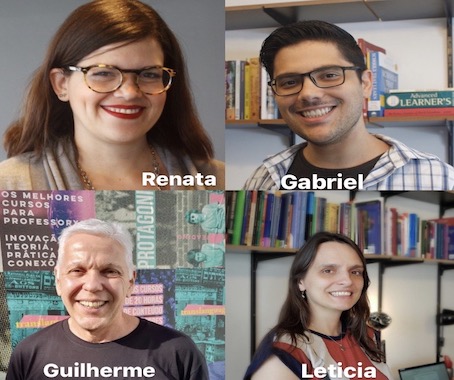In Brazil, there are 2.5 million teachers who teach 50 million students in 200,000 schools. This demonstrates the magnitude of the educational system. Therefore, we are not claiming that everything in this blog post reflects the reality of the whole country. However, we will try to represent with accuracy the current scenario of primary and secondary teacher education in Brazil across diverse contexts.
Brazilian teachers’ profiles
In this blog post, we will focus on primary education (ages 6 to 10), lower secondary education (11 to 14), and upper secondary education (15 to 17). Although teachers dedicated to these different age ranges have unique characteristics,
it is worth pointing out what teachers in Brazil have in common:
- Women represent over 80% of the teachers in the country
- The majority of teachers work for the government, either for the city or the state they live in
- There is a significant minority of teachers who have more than one job, as a teacher or not
(Matijascic, 2017)
The data reflects a particular teacher profile in Brazil: women who work for a state or city school.
Primary education teachers
According to the Guidelines and Foundations for Brazilian Education, which date back to 1996, teachers are not required to have a university degree to teach primary learners. Instead, it has been sufficient to take a specific kind of upper secondary programme known as “Curso Normal”. It is not surprising therefore that in 2018 that only 40% of teachers in primary education had a college degree in the foreign language they were teaching. This situation, however, may change, as there is a bill in congress which proposes to require all teachers to have a degree in pedagogy or in the specific subjects they intend to teach.
Lower secondary teachers
In contrast to primary education, English is mandatory in lower secondary schools and teachers are required to have a university degree in teaching. However, this doesn’t mean that all lower secondary teachers have this qualification. As of 2018, 15% of teachers do not adhere to this standard, and only 48% of teachers have a degree in the foreign language they are teaching. Furthermore, education at this level is expected to conform to the National Common Curricular Base (BNCC). This document provides teachers with guidelines about what should be covered during lower secondary years. It includes:
- General competences to be developed in all subjects, including English
- Specific competences to be developed in English lessons
- Standards for each year of lower secondary school. These include listening, speaking, reading and writing skills and work on information and visual literacy
The BNCC is a fairly detailed document which, despites its flaws, can help guide teachers when planning their lessons. The problem, however, is that many of the teachers lack sufficient linguistic and technical skills to follow these guidelines. This becomes more acute when it comes to teaching English as a lingua franca and helping learners develop communicative competence as well as different literacies. To add to the challenges, professional development initiatives in the public sector don’t seem to be able to bridge this gap between what is expected from teachers and their actual expertise.
Upper secondary teachers
The requirements for being an upper secondary teacher are the same as those for lower secondary: a university degree in teaching. Over 93% of teachers at this level have a college degree, and over 55% of teachers who teach a foreign language have a degree in the language they teach. Compared to the other grade levels, more teachers at this level appear knowledgeable and qualified.
Here, a factor that cannot be overlooked is that teachers at this level are also more likely to be hired by language institutes, which usually offer more continuous professional development than primary and secondary schools. Although teachers might be exposed to new techniques and approaches, we need to bear in mind the differences between the schools’ realities and the language institutes. The latter tend to have fewer students per class, and classes tend to be allocated by language level rather than only by age. It is questionable, then, how this exposure to varying contexts can be transferred to larger groups in primary and secondary schools.
Towards potential standardisation
In recent years, this push for clearer standards (in terms of the curriculum and teacher education) has led to debates regarding teacher roles and the importance of continuous professional development. However, as we have seen, there is still considerable catching up to do in order to ensure those who are currently teaching meet these standards. While this is particularly noticeable in primary education, we have found that at all levels many teachers are not specialised in what they are teaching. With this in mind, we believe that there is room for new programming for in-service teaching professional development. This might include pedagogical needs which are frequently overlooked such as:
- multiliteracies
- English as a lingua franca
- working creatively with limited resources
- the dynamics of teaching larger groups
- learner training for independent learning
- teaching students with special educational needs
Perhaps more creative collaboration between public and private sectors can inspire new models for continuing professional development that can address the challenges facing Brazil ELT today.
References
Matijascic, M. (2017). Professores da educação básica no Brasil: condições de vida, inserção no mercado de trabalho e remuneração. Retrieved from: http://www.ipea.gov.br/portal/images/stories/PDFs/TDs/td_2304.pdf

